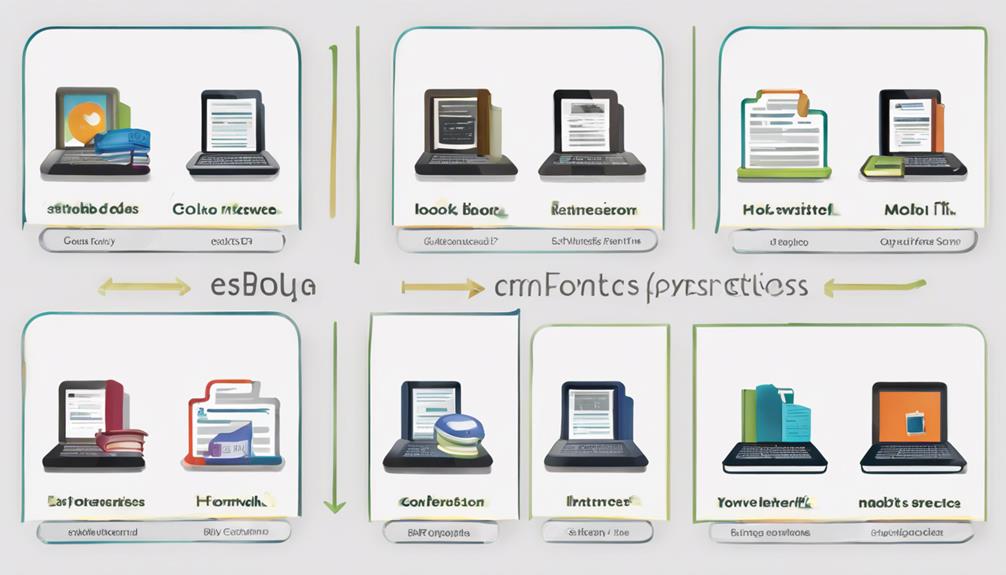When venturing into the realm of self-publishing, you may find it beneficial to explore the book conversion service for self-publishing for a seamless transition from manuscript to a polished final product. Understanding the intricacies of selecting the right provider and preparing your manuscript can significantly impact the outcome of your self-published work. Remember, the devil is in the details, and knowing how to navigate through the conversion process can be the key to achieving professional results that stand out in the competitive world of self-publishing.
Research Self-Publishing Platforms
If you are considering self-publishing your book, the first step is to research self-publishing platforms. Conducting a comparison analysis of different platform options is crucial to find the one that best suits your needs and goals. Look into popular platforms like Amazon Kindle Direct Publishing, Apple Books, Barnes & Noble Press, and others to understand their features, royalty rates, distribution networks, and fees.
When comparing platforms, consider factors such as ease of use, marketing tools provided, publishing formats supported, and overall reputation within the self-publishing community. Some platforms offer expanded distribution options, while others focus on specific genres or target audiences. It’s essential to weigh these factors against your own publishing objectives to make an informed decision.
Take the time to read reviews, join self-publishing forums, and seek recommendations from other authors who have used these platforms. By doing a thorough comparison analysis of platform options, you can choose the one that aligns best with your self-publishing aspirations.
Choose a Book Conversion Service
When selecting a book conversion service for your self-publishing needs, it’s crucial to consider a few key points. Tips for choosing the right service include looking at their track record, pricing structure, and customer reviews. Additionally, assessing the quality criteria they adhere to will help ensure your final product meets your expectations.
Service Selection Tips
Wondering how to choose the right book conversion service for your self-publishing needs? When selecting a service, start by comparing pricing, reading customer reviews, and examining turnaround times and custom options. Pricing comparison is crucial; look for transparent pricing structures and ensure the cost aligns with your budget. Customer reviews can provide valuable insights into the quality of service and customer satisfaction levels.
Consider the turnaround time offered by each service. Some may promise quicker conversions, while others could have longer processing times. Evaluate if the timeframe meets your publishing schedule requirements. Custom options are also essential; check if the service offers tailored solutions like formatting preferences or additional features.
Quality Assessment Criteria
To effectively choose a book conversion service for your self-publishing project, it is crucial to establish quality assessment criteria that align with your specific needs. When evaluating a conversion service, focus on conversion accuracy, a critical aspect that ensures your book’s content is faithfully transferred to digital formats. Look for providers with a track record of high conversion accuracy to avoid errors in the final product. Additionally, consider customer feedback to gauge the satisfaction levels of past clients. Reviews and testimonials can offer valuable insights into the service quality and reliability.
Quality control is another vital factor to consider. Ensure that the conversion service has robust quality control measures in place to maintain consistency and accuracy throughout the process. A reliable service should have a thorough quality assurance process to catch and rectify any errors promptly.
Lastly, consider the turnaround time offered by the conversion service. Balancing speed with quality is essential, so opt for a service that can deliver efficient results without compromising on accuracy. By prioritizing conversion accuracy, customer feedback, quality control, and turnaround time, you can make an informed decision when selecting a book conversion service for your self-publishing needs.
Format Your Manuscript
Once you have completed writing your manuscript, the next crucial step is to format it correctly. Font selection plays a key role in the readability and overall aesthetic of your book. Choose a clean, easy-to-read font such as Times New Roman or Arial in a size between 10-12 points for the main body text. Headings and subheadings can be slightly larger to help with hierarchy and navigation within your manuscript.
Ensure consistent page numbering throughout your manuscript. Typically, page numbers are placed in the header or footer of each page, either centered or aligned to the outer corner. Starting the numbering on the first page of the main text and continuing sequentially is standard practice. Remember to exclude the title page and any preliminary pages from numbering or use Roman numerals for them.
Properly formatting your manuscript not only enhances its professional appearance but also makes the conversion process smoother when working with a book conversion service.
Decide on Your Book’s Layout
Now that your manuscript is meticulously formatted, the focus shifts towards determining the layout of your book. When deciding on your book’s layout, consider elements such as font choice, margins, chapter breaks, and headings.
Font choice plays a significant role in how your book is perceived by readers. Select a font that is easy to read and aligns with the tone of your content. Common choices include Times New Roman, Garamond, or Arial. Ensure consistency in font style and size throughout your book to maintain a professional appearance.
Margins also play a crucial role in the aesthetics of your book. Adequate margins provide breathing space for the text and prevent the content from feeling cramped. Standard margin sizes range from 0.5 to 1 inch, depending on your preference and the requirements of your book.
Chapter breaks and headings help organize your content and guide readers through the book. Clearly distinguish chapter breaks with a consistent style, such as centered or bolded text. Headings within chapters can also aid in navigation and enhance readability. Consider these layout elements carefully to create a visually appealing and reader-friendly book.
Submit Your Manuscript for Conversion
When submitting your manuscript for conversion, ensure it is in a compatible file format such as Word or PDF. Provide detailed metadata and specific instructions about your book, including font preferences, headers, and footers. Additionally, communicate your cover design preferences, whether you have a specific image in mind or require assistance in creating one.
Manuscript File Format
For optimal results in the conversion process, ensure your manuscript is submitted in the appropriate file format. When preparing your manuscript for conversion, consider the following file compatibility and formatting guidelines:
- File Compatibility: Ensure your manuscript is in a widely-accepted format such as Microsoft Word (.docx) or PDF. This will help prevent any technical issues during the conversion process.
- Formatting Guidelines: Stick to a consistent font and size throughout your manuscript. Avoid using complex formatting, such as multiple columns or intricate tables, as these may not translate well during conversion.
- Images and Graphics: If your manuscript includes images or graphics, make sure they are high-resolution and inserted in the document properly. Consider providing separate image files for better quality.
- Avoid Special Characters: Minimize the use of special characters or symbols that may not be supported in the conversion process. Stick to standard punctuation and symbols to ensure a smooth transition.
Metadata and Details
To ensure a seamless submission process for converting your manuscript, attention to metadata and detailed information plays a vital role. When submitting your manuscript for conversion, data accuracy is key. Make sure all metadata such as author name, book title, and ISBN are correct. This ensures that your book is accurately represented in online databases and catalogs. Additionally, optimizing your title is essential for discoverability. Choose a title that is relevant to your book’s content and resonates with your target audience. A well-crafted title can significantly impact the visibility of your book in search results and attract potential readers. Providing accurate and detailed metadata, along with a carefully optimized title, sets the foundation for a successful self-publishing journey. By paying attention to these elements, you increase the chances of your book reaching the right audience and standing out in a crowded market.
Cover Design Preferences
With regards to the submission of your manuscript for conversion, ensuring your cover design preferences are clearly communicated is paramount. When conveying your preferences to the book conversion service, pay close attention to the following key elements:
- Color Scheme: Specify the color palette you envision for your book cover. Whether you prefer vibrant and eye-catching colors or a more subdued and elegant look, providing detailed information will help the designers bring your vision to life.
- Font Selection: Choose fonts that align with the genre and tone of your book. From elegant serif fonts to modern sans-serif styles, the right font can enhance the overall appeal of your cover.
- Imagery: Communicate any specific images or graphics you want to incorporate into the design. Whether it’s a symbolic icon or a relevant illustration, clear instructions will assist the designers in creating a visually appealing cover.
- Layout Preferences: Indicate any layout preferences you have, such as the placement of text, images, and other design elements. Clarity on the arrangement will ensure a cohesive and professional-looking cover design.
Review the Converted File
Upon receiving the converted file of your self-published book, it is crucial to meticulously review it to ensure accuracy and consistency. Start by checking formatting to ensure that all elements such as headings, paragraphs, and page breaks are correctly aligned. Pay close attention to font styles, sizes, and spacing to guarantee a visually appealing layout. Additionally, proofread the text thoroughly to catch any spelling, grammar, or punctuation errors that may have occurred during the conversion process. Look out for any missing or duplicated content and make sure that all images and illustrations are displaying correctly within the document. It is essential to verify that the table of contents, index, and any other navigational features are functioning as intended. By carefully reviewing the converted file at this stage, you can identify and address any issues before proceeding to the next steps of self-publishing your book.
Make Necessary Revisions
After carefully reviewing the converted file of your self-published book for accuracy and consistency, the next step is to address any necessary revisions. When it comes to making revisions, it’s crucial to ensure that your content is polished and error-free. Here’s a guide on how to effectively handle this stage:
- Engage in the editing process: Consider investing in professional proofreading services to catch any overlooked errors.
- Seek content revisions: Look for opportunities to enhance the overall quality and coherence of your manuscript based on feedback from beta readers or editors.
- Incorporate manuscript feedback: Take into account any constructive criticism or suggestions provided by experts in the field to refine your work.
- Double-check for consistency: Verify that your revisions have not introduced any inconsistencies in plot, character development, or style.
Frequently Asked Questions
How Do I Handle Copyright and ISBN for My Self-Published Book?
When self-publishing, handle copyright registration through the official website or ISBN acquisition from Bowker. Check works’ public domain status or use fair use for copyrighted content. Protect your book legally and professionally for successful publishing.
Can I Use Images or Illustrations in My Converted Book?
Absolutely! Regarding image placement, ensure you have the necessary permissions to avoid copyright issues. Utilize illustrations wisely, as they can enhance your book. Remember, ISBN requirements also apply to images and illustrations in your converted book.
Are There Any Restrictions on Fonts and Colors for Conversion?
When converting, font restrictions ensure readability on various devices. Stick to common fonts like Arial or Times New Roman. Color restrictions are in place to prevent issues with grayscale conversions. Opt for simple, high-contrast colors.
What File Formats Are Accepted by Book Conversion Services?
Book conversion services typically accept file formats like Word documents, PDFs, and ePub for eBook compatibility. They offer various formatting options and allow image inclusion for a visually appealing final product. Consider these factors when preparing your manuscript.
Do Book Conversion Services Offer Distribution Assistance?
Yes, book conversion services often provide distribution assistance. They can guide you on marketing strategies and pricing options. Additionally, they help with formatting guidelines and design features for a seamless self-publishing process.



